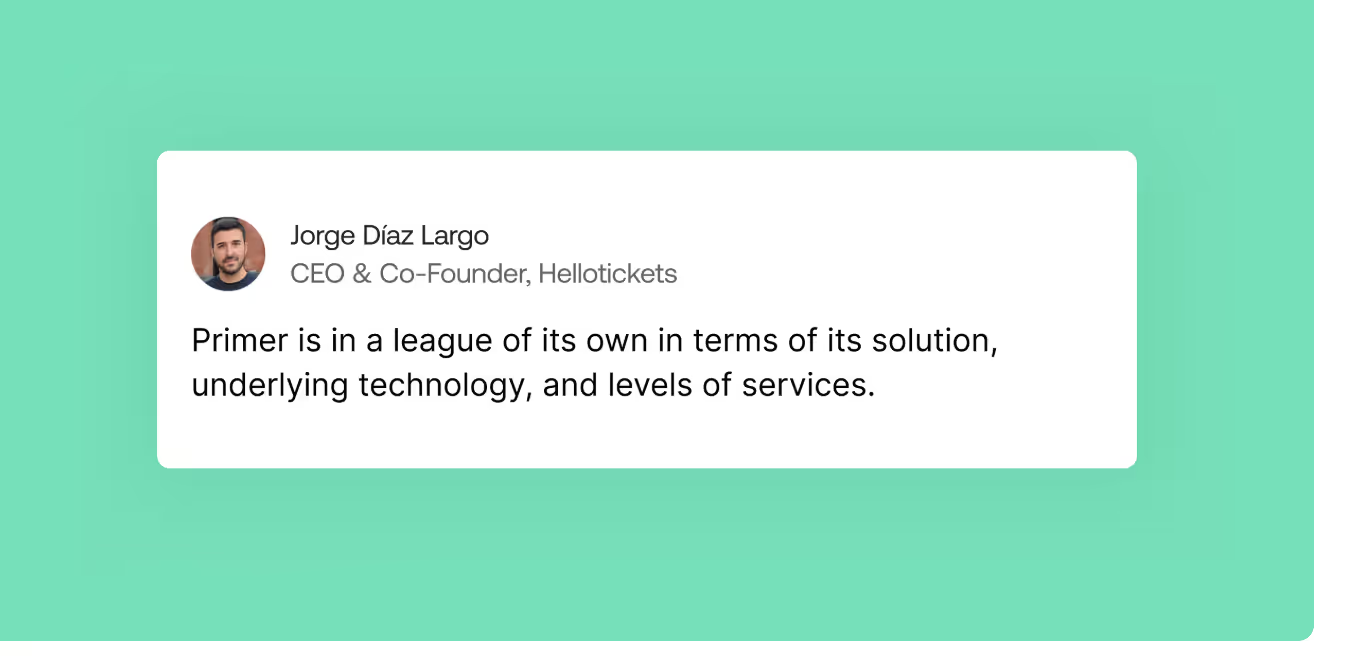You’ve got a strategy in mind. You want to test different payment methods, optimize for conversion, and maybe route low-value transactions through a lower-fee processor. But every idea hits the same wall: a ticket to engineering, a long wait, and a low priority.
Even something as simple as changing the order of payment methods at checkout can turn into a multi-week delay. And by the time it’s live, the window of opportunity has passed.
That’s why more merchants are turning to no-code payment solutions: to move faster without being bottlenecked by technical teams. But with so many tools on the market, and each using different language to describe similar features, it’s easy to get lost.
This guide breaks down what a no-code payment solution actually means, what to look for, and why payment orchestration might be the smartest way to take control.
Ready for one tool that simplifies and unifies all of your payment systems? Book a call with our experts now.
What is a no-code payment solution?
Most payment solutions weren’t built for the people who actually manage payments. They were built for developers. Interfaces are clunky, changes require code, and even small experiments mean waiting on engineering.
This approach made sense in the early days of online commerce. Payments were treated as technical plumbing. You integrated them once and moved on.
But that world no longer exists. Today, payments are a key part of growth, customer experience, and operational efficiency. And the people driving that strategy are not engineers. They’re payment leads, operations managers, and finance teams, who are too often blocked by tools that still assume developer access.
This is where no-code payment solutions come in.
A no-code payment solution is a tool that gives non-technical users the ability to control and optimize the payment experience without writing code. That might include configuring payment methods, editing checkout layouts, setting routing logic, or building workflows using a visual editor.
Some setups may still require light integration. But the ongoing work, such as testing ideas, adding services, and adapting to change, can be done independently by the teams that actually own the outcome.
No-code payment solutions remove bottlenecks and give organizations the speed and control they need over their payments.
There is no one-size-fits-all definition for a no-code payment solution. In practice, many no-code tools are actually low-code, requiring minimal technical setup or copying and pasting a line of code or two.
What is payment orchestration?
Payment orchestration brings all your payment services—like PSPs, payment methods, and fraud tools—into one place. Instead of stitching together separate integrations, you manage everything through a single platform.
This allows your team to launch new providers, adjust routing logic, and update the checkout experience without relying on engineering. Orchestration platforms give payment teams the flexibility to scale into new markets, experiment with different flows, and stay agile when priorities shift.
Some payment orchestration platforms are starting to offer low-code or no-code interfaces, making it easier for non-technical teams to take control and drive strategy without delays.
Read more: What is payment orchestration and how can it maximize payment efficiency?
Checklist: What should you look for in a no-code payment orchestration platform?
Here are some of the key questions to ask as you choose a payment orchestration solution for your organization:
1. Does the platform offer built-in tools for getting the most out of payment routing?
Your platform should do more than support basic routing, it should help you actively optimize performance and recover revenue. Look for built-in tools that let you:
- Build a Fallback strategy to recover more revenue by automatically retrying failed payments with a backup processor, also known as cascading payments.
- Easily build and customize advanced payment routing logic based on variables you determine, without being constrained by preset flows or limited platform options.
- Utilize fraud tools and 3DS as you see fit (assuming you meet regulatory requirements) to enhance authorizations without introducing unnecessary friction or additional costs.
2. Will this platform’s team act as my partner-in-payments, supporting my success with specialized knowledge?
Technology is only part of the equation. You need a team behind the platform that understands your business and is invested in your success.
It’s critical to work with a platform that has a dedicated customer success team. You need someone who knows the ins and outs of the platform to train your team to use it effectively, answer key questions, and troubleshoot any issues that may arise.
At Primer, our experts take the time to understand your business and its goals, then identify the best way to help you reach them. If needed, we’ll work directly with your leadership team to shape a tailored payment strategy and guide you through its implementation.
Learn how Primer commits to your success with dedicated product support.
3. Does this platform power a data-driven approach to payment strategy?
The best platforms don’t just process payments, they give you the tools to deeply understand and optimize them.
Look for a solution that empowers your teams to:
- Synchronize your finance and operations teams’ tools to eliminate silos and align decision-making.
- Closely monitor performance and spot opportunities for optimization.
- Set up real-time alerts to act immediately in case of anomalies or performance issues.
- Utilize a range of dashboards, charts, and filters to clearly visualize key KPIs and examine the relationships between success metrics.
4. Does this platform support my other business needs?
As a payments leader, you’re increasingly responsible for strategic decisions that add value across your organization. With a leading payment orchestration platform you can leverage third-party applications to build additional layers of interconnectivity across departments.
For example:
- By connecting your payment stack to tools like Zendesk, you can automatically trigger support tickets when high-value transactions fail—so your team can step in fast, recover revenue, and deliver a better customer experience.
- Take the weight off your marketing team by triggering automatic Mailchimp or Omnisend campaigns when a key payment event, such as a subscription payment failure, occurs.
- Configure webhooks to stream payment event data to Snowflake, BigQuery, or your business intelligence tools, enabling real-time reporting to your finance, analytics, and growth teams.
5. Does this platform meet the specific needs of my organization?
Whether you’re trying to take your apparel brand global or add new continents to your online travel agency’s roster, you need a payment orchestration platform that can flex to meet the precise requirements of your business.
When choosing a solution, ask yourself:
- Does it help you make sense of your data? Does the platform simplify and unify your access to payment data across payment processors, or is it yet another siloed tool in an already fragmented payment stack?
- How is the UX? Does the platform make it easy to build and adapt routing logic without requiring developer engagement? Is it intuitive enough that any member of your team could learn to use it?
- Can you tailor the customer experience to meet the needs of different markets? Does the platform limit your control over how payment methods are shown, or can you decide what appears for each customer in each market?
- Does the checkout look like your brand? Does the platform let you customize the look and feel of your checkout to reflect your brand’s identity? Can you create your own unique styling, or does the platform restrict you to generic templates?
- Can it handle your compliance needs? Does the platform give you the tools and flexibility you need to meet specialized or regional standards? Does it enable you to meet the legal requirements in highly regulated industries, such as iGaming or crypto?
The bottom line? Your payments should be as flexible and dynamic as the business you’re growing, so look for tools that flex to fit your business, not the other way around.
Learn more: Your ultimate payment orchestrator buyer’s guide
Why choose Primer as your no-code payment solution
Most payment tools weren’t built for the people who manage payments. They were built for developers.
That legacy shows up everywhere: inconsistent terminology, clunky dashboards, complex integrations, and weeks of engineering time to make even small changes.
The result is that payments became something only technical teams can touch, leaving strategy, optimization, and experimentation on hold.
Primer changes that.
We give your team a single platform to connect every payment service, manage the full payment lifecycle, and move faster: without relying on engineering.
Standardizing the language of payments
One of the biggest hidden costs in payments is inconsistency. Every PSP has its own terminology, its own field structures, its own logic.
For example, while Visa and Mastercard define the rules for decline categories, processors interpret them differently. Stripe might return insufficient_funds as a clear text response, while Adyen returns a numeric code like 12, which merchants must decode using their documentation.
Multiply this type of complexity across fraud vendors, digital wallets, and regional providers, and your organization ends up spending most of its payment resources translating between systems rather than focusing on strategy.
Primer removes this layer of friction. All services plug into the same infrastructure. Data is normalized, field names are consistent, and payment flows follow the same structure across every provider. You no longer need to manage each integration as a separate project. You just work with Primer.
This standardization makes onboarding new services faster, reduces error handling, and gives you one common language to work across your payment stack.
Giving your team flexibility and ownership over payments
The people driving payment performance aren’t always technical. They’re product managers, finance leads, and operations teams. Primer makes payments accessible to all of these teams.
With Primer, your non-technical teams can launch new providers, configure fraud tools, route payments by geography or value, and adapt the checkout experience: all without writing a line of code.
For instance,
- Universal Checkout lets you control how the customer experience looks and behaves.
- Workflows let you set up payment routing using drag-and-drop functionality.
- Fallbacks help you recover revenue by automatically retrying failed transactions with a backup processor of your choice.
- Observability empowers your team to monitor performance in real time, identify issues across processors and payment methods instantly, and drill down into failure reasons without relying on engineering.
With Primer, your team isn’t just maintaining payments. They’re actively improving them, without waiting on a backlog.
Trusted by market-leading merchants
Some of the most ambitious brands in the world use Primer to take control of their payments and unlock faster growth. Here are just a few examples:
- Eldorado is one of the leading online marketplaces for in-game currencies, items, and services. As it expanded globally, the team faced the challenges that come with a fragmented payment setup. Multiple PSPs. Manual routing. One-off integrations. It was hard to manage, and harder to scale.
With Primer, Eldorado gained reliability through multi-PSP redundancy, the ability to launch in new regions quickly, and full control over routing, retries, and analytics. Today, teams beyond payments, like finance and support, are also using Primer to improve operations and deliver a better customer experience.

Read more: Why Primer’s payments platform is a game-changer for Eldorado
- Hellotickets is a leading travel experience platform that helps international travelers book tickets, tours, and activities in their own language and currency. But operating in over 20 countries has introduced some significant payment challenges.
Founder Jorge Díaz Largo knew the business needed more flexibility. Local payment preferences, fraud risk, and performance varied by market, and the existing stack couldn’t keep up.
Primer stood out for its ease of use, fast onboarding, and infrastructure that could adapt without compromise. With Universal Checkout, Hellotickets can now create tailored checkout experiences by region, expand local methods like PIX, and consolidate all payment data into one place to inform strategy.

Primer stood out for its ease of use, fast onboarding, and infrastructure that could adapt without compromise. With Universal Checkout, Hellotickets can now create tailored checkout experiences by region, expand local methods like PIX, and consolidate all payment data into one place to inform strategy.
Read more: Hellotickets opens up the world of payments with Primer
These three businesses operate in very different spaces, but they all faced the same constraint: rigid payment systems that slowed them down. Primer gave them a flexible foundation to scale faster, adapt to new markets, and turn payments into a strategic advantage.
Unlock control and adaptability with Primer
In a nutshell, Primer gives your team control and flexibility over payments.
Instead of waiting on devs or settling for platform limits, you can move fast, experiment freely, and build a payment strategy that drives real performance.
Primer brings all your payment tools together, enabling you to execute your strategy quickly and effectively. This empowers your team to focus on growth, rather than working on the back foot.
Book a call to learn more.
FAQs: How to choose a no-code payment solution in 2025
1. What is a no-code payment solution?
A no-code payment solution gives non-developers the ability to manage and optimise payment flows without engineering help. Primer offers this through a unified platform that lets teams control routing, checkout, and integrations visually.
2. Who should use a no-code payment platform?
Merchants and payment teams who need to move quickly without relying on developers benefit most. Primer is built to give these teams the control they need—so they can experiment, launch providers, and adapt to change without bottlenecks.
3. How is a no-code payment solution different from a payment processor?
While processors move money, a platform like Primer connects all your processors, fraud tools, and payment methods under one roof. You manage them through no-code workflows, making your payment stack easier to scale and optimise.
4. Can a no-code payment solution improve conversion rates?
Yes—especially when using a platform like Primer. With features like smart routing, fallback logic, and customisable checkout flows, teams can quickly test ideas and reduce friction, leading to better payment performance.
5. What should you look for in a no-code payment orchestration platform?
Look for real-time visibility, flexible integrations, no-code routing tools, and strong support. Primer delivers all of these, helping you streamline operations and build a scalable, high-performance payments setup.




(1).png)
.png)